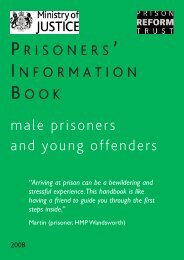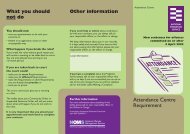Resettlement provision for children and young ... - Ministry of Justice
Resettlement provision for children and young ... - Ministry of Justice
Resettlement provision for children and young ... - Ministry of Justice
You also want an ePaper? Increase the reach of your titles
YUMPU automatically turns print PDFs into web optimized ePapers that Google loves.
Despite their key role, the attendance <strong>of</strong> social workers at training planning meetings <strong>for</strong> looked<br />
after <strong>children</strong> was poor. In contrast, relationships with community-based youth <strong>of</strong>fending teams<br />
(YOTs) were well developed <strong>and</strong> YOT case managers normally attended training planning<br />
meetings. However, plans were not always finalised in time <strong>for</strong> the pre-release meeting which,<br />
underst<strong>and</strong>ably, worried <strong>young</strong> people <strong>and</strong> frustrated case supervisors. Two <strong>of</strong> the 61 <strong>young</strong><br />
men interviewed said that not having accommodation had prevented their early release, but no<br />
establishments monitored this. It was not evident that discussions were taking place about<br />
whether accommodation arrangements set up at the point <strong>of</strong> release were suitable <strong>and</strong><br />
sustainable.<br />
In our case sample, 61% <strong>of</strong> <strong>young</strong> men said they would be living with family on release <strong>and</strong> the<br />
majority were optimistic about it as they felt their family’s support was the key to their<br />
successful resettlement. Although establishments realised the importance <strong>of</strong> <strong>young</strong> people<br />
maintaining contact with family where appropriate <strong>and</strong> encouraged it, more structured work<br />
needed to be done to rebuild or maintain relationships while <strong>young</strong> people were in custody.<br />
This left two-fifths <strong>of</strong> our sample who required accommodation to be arranged <strong>for</strong> their release,<br />
which was a vital step be<strong>for</strong>e other release plans could be put in place. Case supervisors<br />
reported a range <strong>of</strong> barriers to finding suitable accommodation, including a limited supply <strong>of</strong><br />
local authority housing <strong>and</strong> issues around the <strong>young</strong> person’s behaviour or <strong>of</strong>fence. They also<br />
reported a range <strong>of</strong> barriers to arranging ETE <strong>for</strong> release, including limited availability in the<br />
community. At the time <strong>of</strong> interview, only 14 <strong>of</strong> the 48 <strong>young</strong> men who said they wanted to<br />
continue education had a place arranged. Worryingly, <strong>of</strong> the 42 <strong>young</strong> men who said they<br />
wanted to work (either full-time or part-time alongside education), only nine reported that they<br />
had a job arranged on release – <strong>and</strong> <strong>for</strong> seven <strong>of</strong> these it had been arranged through family,<br />
without help from the establishment or the YOT.<br />
Follow-up in<strong>for</strong>mation was requested from case supervisors on what happened to the <strong>young</strong><br />
men in our case sample on release <strong>and</strong> a month later, with in<strong>for</strong>mation received <strong>for</strong> 41 <strong>and</strong> 37<br />
<strong>of</strong> the <strong>young</strong> men respectively. Only 13 <strong>young</strong> men (32%) had both suitable accommodation<br />
(as assessed by case supervisors) <strong>and</strong> ETE on release. Two, including a looked after child,<br />
were <strong>for</strong>ced to report as homeless. One in five were placed in accommodation assessed as<br />
unsuitable by case supervisors; this included three <strong>young</strong> men who had had to go into bed <strong>and</strong><br />
breakfast lodgings – one was still there a month later – <strong>and</strong> two who were living with family<br />
where this was a cause <strong>for</strong> concern. Only a third <strong>of</strong> <strong>young</strong> men had an ETE placement<br />
arranged on release, only half <strong>of</strong> these were still attending a month later <strong>and</strong> only a fifth <strong>of</strong><br />
those who had not got a placement on release had one confirmed a month later. Where ETE<br />
placements had fallen through, case supervisors felt this was due to unstable accommodation,<br />
a lack <strong>of</strong> family support, the <strong>young</strong> person’s lack <strong>of</strong> motivation or problems due to the timing <strong>of</strong><br />
course start dates. A month after release six <strong>of</strong> the <strong>young</strong> men were in custody <strong>and</strong> one was<br />
‘on the run’ – three <strong>of</strong> the <strong>young</strong> people who had returned to custody were looked after<br />
<strong>children</strong>.<br />
This report raises a key question – how effective is the resettlement work conducted in custody<br />
in terms <strong>of</strong> the actual outcomes <strong>for</strong> <strong>young</strong> people This was not monitored by establishments<br />
<strong>and</strong> our follow-up in<strong>for</strong>mation highlights the need to look beyond the gate in order to evaluate<br />
the effectiveness <strong>of</strong> resettlement work. Overall the outcomes <strong>for</strong> our sample were very<br />
disappointing. The Heron unit, although we can make no conclusions based on our small<br />
sample, seemed a promising initiative, as did the resettlement consortia, although the <strong>young</strong><br />
10

















